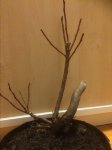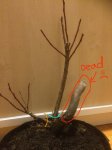Hello
@Bavarian Raven - sorry I did not drop into this thread right away. I usually read BNut, while away from my laptop and which threads get looked at is pretty random. The reason Sorce tagged me is that my cousins and I as a group bought a blueberry farm in SW Michigan a couple years ago. This winter, on my ''To Do'' list is "prune 1200 blueberry bushes in field 3 and 430 bushes in field 2". Of course pruning for fruit is pretty much the exact opposite to pruning for bonsai.
Blueberries in general, and the ones used for commercial fruit production specifically, require an acidic soil, more acidic than what an azalea needs. In the plant world, they are considered ''calcifuges'' in that they want a potting medium that has a low calcium/magnesium content. They do well with soil pH between 4.0 to 6.0, and will ''just barely'' tolerate pH up to about 6.5. The closer to neutral, 7.0, the more important it is to water them with water that has low alkalinity, or low total dissolved solids. Rain water is best, RO, distilled, or water collected from dehumidifiers or other condensation sources will work too. Some parts of the Pacific Northwest are lucky enough to have soft water for their municipal water sources, maybe you are lucky in that respect, otherwise I suggest collecting rain water, to supplement when you don't get enough rainfall.
Both at the farm in Michigan and where I live between Chicago and Milwaukee, the tap water in both places has a fair amount of dissolved Calcium, roughly 220 parts per million total dissolved solids with 175 ppm as calcium carbonate total alkalinity. This is ''medium'' on the hard water spectrum for municipal water supplies, but it is more calcium than any blueberry wants to see. I try to water my blueberries in pots with rain water I collect. I do use municipal tap water when I run out of collected rain water, but I try to not do that for extended periods. Fortunately we get rain often enough that I have not had to use tap water for more than 6 weeks in summer.
The potting medium I use for blueberry bonsai is a blend of roughly equal parts of sifted pumice, sifted kanuma, sifted fine fir bark, preferably composted for a year & sifted Canadian peat moss. Majority of peat will fall through a fine sieve, I throw the fines onto the vegetable garden. The peat that is retained on a 2 mm screen (screen typically used as window screen is near this size) is what I use. Peat moss does break down, blueberries in this mix will need repotting every 24 to 36 months or so in my climate. At first, peat as it breaks down becomes more acidic, which is good, then suddenly the pH starts climbing, becoming more alkaline, which is bad. SO the need to repot every 2 to 3 years is to avoid the peat accumulating calcium and becoming too close to a neutral or alkaline pH. If you are growing blueberries in nursery size pots, a mix of just fir bark, or pine bark and Canadian peat moss is all you need. You can throw in up to 20% sawdust too. In a bonsai pot the structure from the pumice is helpful. Top dress with live moss, or dry long fiber sphagnum moss to hold the light kanuma into the pot. Perlite can be substituted for pumice in this mix. Perlite is very light, so the moss top dressing is very important. In commercial fields sawdust is the preferred mulch, you can add some sawdust, maybe up to 20% to your potting mix with good results. Hardwood sawdust is best, avoid walnut sawdust. Pine sawdust will work too, but hardwood has the best effect in commercial fields. The mycelium associated with blueberries is a facultative saprophyte, the sawdust feeds the endomycelium associated with blueberries. For those who have alkaline soils in their gardens, and want to grow blueberries for fruit, use containers, the nursery trade ''20 gallon'' size or larger will work. Wide & shallow is better than deep. Half a wine barrel is perfect. A highbush blueberry in this size pot will yield 4 pounds of fruit fairly reliably, and 10 pounds is possible if your care and fertilizing is good.
Water soluble Fertilizer - DO NOT USE A FERTILIZER THAT LISTS CALCIUM OR MAGNESIUM IN SIGNIFICANT AMOUNTS. The Cal-Mag fertilizers from Peters, or Dyna Gro, or Green Care, all have calcium in quantities that approach or exceed the amount of Nitrogen. This type of fertilizer will kill a blueberry dead, possibly in a single application - I killed a couple thousand or so first season cuttings with a hit of MSU Orchid fertilizer, which is essentially a Cal-Mag formulation. The "Mira Acid" type fertilizers designed for azaleas and evergreens is fine. Any fertilizer with 2% or more Sulfur as a component will work. Calcium in the presence of Sulfur forms an insoluble salt, Calcium sulfate, so formulations for liquid fertilizers, if they have sulfur, will not have added calcium or magnesium. Ammonium sulfate is also a good water soluble nitrogen source. At the low pH that blueberries prefer, they take up nitrogen in the form of ammonia rather than as nitrate. Organic fertilizers such as seaweed, fish emulsion and soybean meal all work well.
Blueberries tolerate a fair amount of shade, but best fruit is in full sun. The Northern Low Bush species, native to northern half of the USA and all of Canada are extremely winter hardy, good to -30 F or -32 C. The Highbush V. corymbosum hybrid varieties then to be hardy only to USD zone 5, with flower bud damage at - 15 F (roughly -25 C) The Rabbit Eye type blueberries are designed for USDA zone 7 and warmer and are suitable for northern Florida through to about Saint Louis Missouri. Your locally native blueberry, or related huckleberries will of course be hardy in your own area. There are 50+ species of Vaccinium native to North America, from Mexico through the Tundra. Huckleberries are in the genus Vaccinium, are similar in horticulture to blueberries, and differ mainly in that they tend to have smaller, less juicy fruit, and a taller, more tree like growth habit. Cranberries are a low ground hugging sub-shrub also in the genus Vaccinium. Hawaii has a tropical member of Vaccinium, that resembles a blueberry in growth habit, but fruit is the size and color of a cranberry with its own unique flavor. The Hawaiian Vaccinium is more tolerant of heat and low humidity than most Vaccinium. as it has fairly leathery leaves. Its a pioneer species on old lava flows.
Notice so far I haven't said shit about blueberries as bonsai - my skill is horticulture, my sense of art and design is ''not so good''.
 ) researching and googling Bonsai and related topics.
) researching and googling Bonsai and related topics. 
 (Heck, if you think I shouldn't even bother with this specimen, feel free to say so as well).
(Heck, if you think I shouldn't even bother with this specimen, feel free to say so as well).



